非谓语动词三步法
非谓语单词解题方法

非谓语单词解题方法一、非谓语动词的概念动词的基本用法是作谓语。
当句中已经有了谓语动词时(或两个句子且没有连词),要选或要填的动词就只能用非谓语的形式了。
二、非谓语形式及基本用法:1、动词不定式:to do 表目的、表将来2、动词的ing(动名词、现在分词):doing 表主动、表进行3、动词的过去分词:done 表被动、表完成三、非谓语动词的时态和语态四、解题方法第一步:辨别“谓语与非谓语”第二步:找非谓语的逻辑主语第三步:判断语态第四步:分析时态第一步:辨别谓语与非谓语There are nine planets around the sun, and the earth one of them.A.moving; beingB. moving; isC.move; beingD. moved; is*一个句子中,已经存在一个主句(谓语动词),又没有连词的情况下,还有别的动词出现时,要用非谓语的形式。
She got off the bus, (leave) her handbag on her seat.She got off the bus, but (leave) her handbag on her seat.第二步:找非谓语的逻辑主语1.作定语时,被修饰的词是逻辑主语a boy called Nana(一个名叫纳纳的男孩)2.作状语时,句子的主语是逻辑主语Having finished the homework, Du Ziteng went to sleep.3.作宾语补足语时,宾语是逻辑主语We saw San Huang singing and dancing.第三步:判断语态在确定逻辑主语之后,分析非谓语动词和逻辑主语是主动还是被动关系。
Finding her car stolen, .A.a policeman was asked to helpB.the area was searched thoroughlyC.it was looked for everywhereD.she hurried to a policeman for help第四步:判断时态根据非谓语自带的时间状语确定时间The problem next is of great importance.The building now is our future classroom.The problem just now is of great importance.A.discussedB.being builtC.to be discussed根据上下文的语境确定时间——Li Ming is said abroad. Do you know what country he studied in?he will study in?he studies in?——Yes, in London.A.to have studiedB. to studyC.to be studyingD. to have been studying五、练习1.There was a terrible noise the sudden burst of light.A.followedB. followingC.to be followedD.being followed2. The Olympic Games, in 776 B.C, didn’t include women until 1912.A.first playingB. to be first playedC.first playedD.to be playing3. What’s the language in Germany?A.speakingB. spokenC.be spokenD.to speak4. The next morning she found the man in bed, dead.A.lyingB. lieyying5.——Good morning. Can I help you?——I’d like to have the package , madam.A.be weightedB. to be weightedC.to weighD.weighted6. If you wave your book in front of your face, you can feel the air against your face.A.movedB. movingC.movesD.to move7. a reply, he decided to write again.A.Not receivingB.Receiving notC.Not having receivedD.Having not received8. The murderer was brought in, with his hands behind his back.A.being tiedB. having tiedC.to be tiedD.tied9. more attention, the trees could have grown better.A.GivenB. To giveC.GivingD.Having given10. Climbing mountains was , so we all felt .A.tiring; tiredB.tired; tiringC.tiring; tiringD.tired; tired11. these pictures, I couldn’t help thinking of those days when I was in Beijing and from the top of a thirty-storeyed building, Beijing looks more magnificent.A.Seeing; seenB. Seen; seeingC.Seeing; seeingD.Seen; seen12. I was fortunate to pick up a wallet on the ground on the way home, but unfortunately for me, I found my colour TV set, when I got home.A.lying; stolenB. laying; stealingy; stolenD.lying; stealing13. , he still could not understand it.A.Told many timesB. Having been told many timesC.He has been told many timesD.Though he was told many times14. On hearing the news, I was too to sleep.A.exciting; excitedB.excited; excitingC.exciting; excitingD.excited; excited15.Mrs White was glad to see the nurse after her son and her daughter and was also pleased to see children well care of in the nursery.A.looked; takenB.looking; takenC.looked; tookD.looking; taking16. I know you like . Would you like with me now?A.to swim; to swimB. swimming; swimmingC.swimming; to swimD.to swim; swimming17. It happened when I left the station, so I had to wait until the rain stopped.A.to be rainingB. to have rainedC.to rainD.raining18. I would appreciate back this afternoon.A.you to callB. you callC.your callingD.you’re calling19. “The light in the office is still on.”“Oh, I forgot ”A.turning it offB. turn it offC.to turn it offD.having turned it off20. “I must apologize for ahead of time.”“That’s all right.”A.letting you not knowB. not letting you knowC.letting you know notD.letting not you know21. I still remember to Beijing when I was six.A.to takeB. takingC.having takingD.having been taken22. It is important for parents and young people to learn how to get through to each other and develop skill in understanding and .A.being understoodB. to be understoodC.understandD.understood23. more trees is good for health and it is also important to stop waste from factories our surroundings.A.To plant; polluteB. Planting; to polluteC.Plant; pollutingD.Planting; polluting24. Big fast food chains in New York City have started to obey a first of its kind rule, them to post calorie counts right on the menu.A.to requireB.requiringC.requiredD.having required25. at the dinner table twice, Marry insisted that she drop out of one of her many after-school activities.A.Having fallen asleepB. To fall asleepC.To have fallen asleepD.Fallen asleep26. from the Song Dynasty, the Confucian Temple of Nanjing has now developed into a famous scenic spot, sightseeing, shopping and tasty foods.A.Having dated; featuredB. Dating; featuringC.Dating; having featuredD.Dated; featuring27. Misunderstandings from lack of social communication, unless with properly, may lead to serious problemsA.resulted; dealtB. resulting; dealtC.resulted; dealingD.resulting; dealing28. With a lot of difficult problems , the newly-elected president is having a hard time.A.settledB. settlingC.to settleD.being settled。
非谓语动词解题策略三步法3-语态与时态的确定原则

D. 完成进行式
在非谓语动词中,只有不定式存在完成进行主动式。其表示不定式所表示的动 作/状态一直延续到句中谓语动词所表示的动作(记作符号“→∣”)。如: She is said to have been living abroad these years. 据说这些年来他一直在国外生活。
非谓语动词解题策略之三步法
B. 当非谓语动词在句中作定语时,应考虑非谓语动词和所修饰n./pron.之间的 关系;
C. 当非谓语动词在句中作宾语补足语时,应考虑非谓语动词和宾语之间的关系;
非谓语动词解题策略之三步法
第三讲非谓语动词语态时态的确定原则
Ⅱ. 非谓语动词 时态的确定原则
非谓语动词的时态是指谓语动词所表示的动作或状态与主要动词(谓语动词)所表示 的动作或状态比较时,两者在发生时间上的先后关系。 A. 一般式 1. 不定式 a. 表示经常性动作/状态或没有明确的先后关系。如: To see is to believe. 眼见为实。 She hates to be flattered. 她不喜欢被奉承。
Ⅰ. 非谓语动词语态的确定原则
非谓语动词的语态是指非谓语动词与其逻辑主语之间的关系。一般地,如果二 者是主谓关系,则非谓语动词用主动式,如果二者是动宾关系,则非谓语动词 使用被动式。 非谓语动词的逻辑主语与其句法功能相关,一般地,
A. 当非谓语动词在句中作表语、宾语、主语补足语和状语时,应考虑非谓语 动词和句子主语的关系;
非谓语动词解题三步走

非谓语动词解题三步走作者:王正勋来源:《高中生·高考指导》2015年第10期第一步:确定是谓语动词还是非谓语动词。
一般来讲,一个句子只有一个谓语动词。
如果是两个谓语动词并列,要有连词连接;如果没有连词,其中一个要用非谓语动词。
如果是三个或三个以上谓语动词并列时,前面几个谓语动词要用逗号分开,最后两个常用and等连词连接,此时的谓语动词所表示的动作常先后接连发生。
否则要根据具体情况,分析动词之间的关系,确定非谓语动词的形式。
如果and等连词不是放在最后两个动词之间,要分析各个动词的关系,确定哪些是用作谓语动词,哪些是用作非谓语动词,再分析动词之间的关系,确定非谓语动词的形式。
例1 A woman saw him crying and telling him to wait outside a shop.解析:答案为将telling改为told。
分析句子结构可知,tell与saw是并列关系,and前后的谓语动词时态要一致,因此将telling改为told。
例2 The old woman carefully sorted out the eggs,_____(put)them in the basket and headed for the market.解析:答案为putting。
分析句子结构可知,put动作应该与sort out动作同时发生,虽然三个动词中最后两个用and连接,但三个动词并不是接连发生,因此put不能用作谓语动词,而用现在分词充当伴随状语。
第二步:根据非谓语动词发生时间和谓语动词的时间关系确定非谓语动词的时态,根据非谓语动词与其逻辑主语的关系确定非谓语动词的语态。
1. 若所表示的动作与主要谓语的动作同时或几乎同时发生,或是在它之后发生,则用to do(主动)或to be done(被动)。
2. 若与主要谓语的动作(几乎)同时进行,并强调正在进行的情景或持续性,则用to be doing或doing(主动),being done(被动)。
非谓语动词解题步骤

非谓语这一语法点是非常重要的,从历年来高考涉及的考点我们就能很清楚的看到,但是许多学生由于对非谓语的解题步骤不甚清楚,导致做题错误率很高。
在一对一教学中,我们也经常看到同学们犯这样的错误。
下面我们就来具体分析非谓语的解题步骤。
在分析解题步骤之前,我们要弄清楚一个概念,那就是:究竟什么是非谓语?我们都知道,对于英语的句子来说,一般情况下一个句子只可以有一个中心的谓语动词,但如果我们想表达更复杂的思想,需要两个或两个以上的动词来完成句子怎么办呢?我们可以有以下三种途径:第一、用连词“and,or ”等连接两个简单的句子,构成并列句;第二、用关系词“which、that、when”等构成我们非常熟悉的三大从句(定语从句,状语从句,名词性从句);第三、用非谓语的形式将动词变形,放在句子中做除了谓语以外的其他成分。
我们都知道非谓语分为三大类:不定式、动名词、和分词。
这三大类非谓语的命名是十分讲究的,我们之所以称不定式为不定式,正是因为它在句子当中充当的成分是最不定的,除了谓语外的六种成分——主宾表定状补,它都可以充当。
动名词本身是由动词变化而来,同时又具有名词的性质,因此我们称其为动名词,这也就不难理解它在句子中为什么常常充当主宾表定;分词,顾名思义,由动词分化而来的现在分词和过去分词,相当于形容词或者副词的作用,这也为什么它常在句子中充当定表状补的原因。
如下表所示:功能形式主语宾语表语定语状语补语不定式√√√√√√动名词√√√√××分词××√√√√时态和语态一般完成形式主动被动主动被动v-ing Doing Being done Having done Having been done v-ed ×Done ×DoneTo do To do To be done To have done To have been done下面我们来分析非谓语的解题步骤:一、分析句子结构1. ________many times , but he still couldn't understand it .(有并列连词,并列句)2. ________many times , he still couldn't understand it .(无连词,非谓语)A. Having been told .B. He was toldC. Told上面的句子中,已经有很清楚的标注,我们不再赘述,在选择非谓语的不同形式之前我们一定要分清楚是并列句、从句还是简单句。
非谓语动词分步讲解
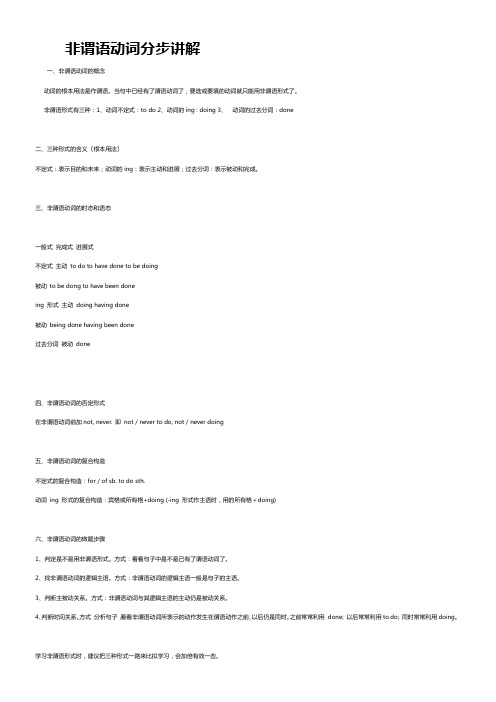
非谓语动词分步讲解一、非谓语动词的概念动词的根本用法是作谓语。
当句中已经有了谓语动词了,要选或要填的动词就只能用非谓语形式了。
非谓语形式有三种:1、动词不定式:to do 2、动词的ing : doing 3、动词的过去分词:done二、三种形式的含义〔根本用法〕不定式:表示目的和未来;动词的ing:表示主动和进展;过去分词:表示被动和完成。
三、非谓语动词的时态和语态一般式完成式进展式不定式主动to do to have done to be doing被动to be dong to have been doneing 形式主动doing having done被动being done having been done过去分词被动done四、非谓语动词的否定形式在非谓语动词前加not, never. 即not / never to do, not / never doing五、非谓语动词的复合构造不定式的复合构造:for / of sb. to do sth.动词ing 形式的复合构造:宾格或所有格+doing (-ing 形式作主语时,用的所有格+doing)六、非谓语动词的做题步骤1、判定是不是用非谓语形式。
方式:看看句子中是不是已有了谓语动词了。
2、找非谓语动词的逻辑主语。
方式:非谓语动词的逻辑主语一般是句子的主语。
3、判断主被动关系。
方式:非谓语动词与其逻辑主语的主动仍是被动关系。
4、判断时间关系。
方式:分析句子,看看非谓语动词所表示的动作发生在谓语动作之前、以后仍是同时。
之前常常利用done; 以后常常利用to do; 同时常常利用doing。
学习非谓语形式时,建议把三种形式一路来比拟学习,会加倍有效一些。
一、非谓语动词作主语和表语的比拟1、不定式和动名词作主语和表语a. 不定式表示一次性的、具体的动词。
动词ing 常表示一般的、泛指的或习惯性的动作。
如:________ is a good form of exercise for both young and old.A. The walkB. WalkingC. To walkD. Walk(分析) a good form 暗示泛指一般的行为,用动名词作主语,选 Bb. 不定式作主语时,常常利用it 作形式主语,即用句型:It is + adj. / n. + (for / of sb. ) to do sth.It’s important for us to learn English well.It’s kind of you to help us.注意:下面几个句型是用动名词:It’s no good / use doing sth.It’s useless doing sth.There is no need to do sth.2、不定式、动名词、分词作表语的比拟a、不定式、动名词作表语,.表示主语的内容。
非谓语动词解题步骤及考点

动词的v-ing的基本形式
主动形式 一般式
doing having done
被动形式
being done having been done
完成式
动词的v-ing 中的“时态”
(1).v-ing的一般式表示的动作发生在谓语动词表 示的动作同时或之后 Going down the town , I met a friend. She dreams of becoming a teacher. (2).v-ing的完成式表示的动作,发生在谓语动词 表示的动作之前 He was praised for having done a good deed. Having been given a good chance, he didn’t cherish it at all.
(is hanging ; hangs; hanging )
谓 2.____ the new juice, and you will like it.
(Try; Trying; to try)
★
非 to the party were from 3.Most of the artists ____
South Africa. ( invited; inviting ; was invited, to be invited)
其它考点2-分词的否定
动词-ing形式的否定式是在其前面加not, 如果它用了助动词构成完成式或被动式, 就在助动词前面加not。如: Not knowing his telephone number, I couldn’t ring him. Not having been informed of the meeting, I failed to attend it.
非谓语动词的解题思路

非谓语动词的解题思路在句子中充当除谓语以外的句子成分的动词形式叫做非谓语动词。
非谓语动词分为三种形式:不定式,动名词,和分词(分词包括现在分词和过去分词)。
1)不定式(to do) 表示目的,将来时态\语态主动被动一般式to do to be done完成式to hav e done to hav e been done2)动名词/现在分词–ing 表示主动,同时进行时态\语态主动被动一般式doing being done完成式hav ing done hav ing been done3)过去分词–ed 表示被动,完成的状态否定形式:not + to do,not + -ing,not + -ed在做题过程中,如果能按照“先结构,再语态,后时态”这三步思考,再难的题目也能迎刃而解。
一、先结构。
非谓语动词充当动词的宾语或宾语补足语的时候,它的形式要由前面的动词决定。
因此,我们要先考虑它与前面动词固定搭配的结构形式。
有些动词的宾语只接动词不定式(to do),如agree, ask, decide, expect, pretend, want, wish, learn, seem等;而有些动词或动词短语则要求只能用动名词(-ing)作宾语,如appreciate, av oid, delay, allow, suggest, finish, practice, enjoy, imagine, f orbid, risk, mind, stand, consider, insist on, escape, look forward to等;还有一些使役动词的固定搭配,如hav e sth. done等,动词搭配的结构已经固定了非谓语的形式。
例如:He was pretending ________ while his mother came in his study.A. readingB. to be readingC. readD. be reading只要学生掌握动词pretend后只能接不定式作它的宾语,即pretend to do sth(假装做某事)这个结构的话,一眼就可选出B这个正确答案。
非谓语动词语法口诀
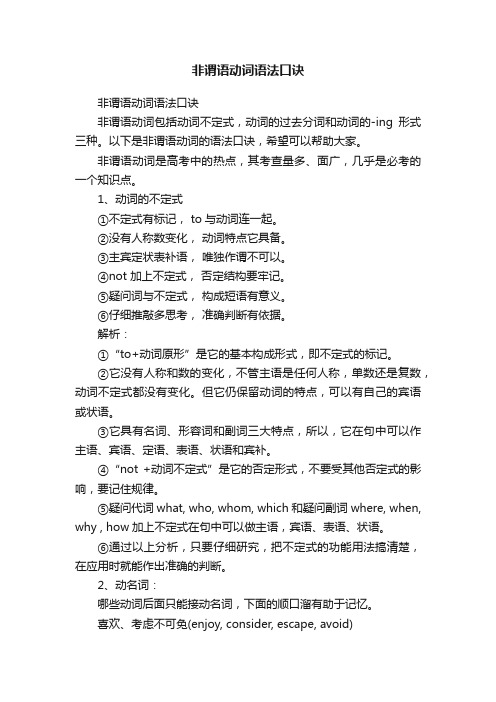
非谓语动词语法口诀非谓语动词语法口诀非谓语动词包括动词不定式,动词的过去分词和动词的-ing形式三种。
以下是非谓语动词的语法口诀,希望可以帮助大家。
非谓语动词是高考中的热点,其考查量多、面广,几乎是必考的一个知识点。
1、动词的不定式①不定式有标记, to与动词连一起。
②没有人称数变化,动词特点它具备。
③主宾定状表补语,唯独作谓不可以。
④not 加上不定式,否定结构要牢记。
⑤疑问词与不定式,构成短语有意义。
⑥仔细推敲多思考,准确判断有依据。
解析:①“to+动词原形”是它的基本构成形式,即不定式的标记。
②它没有人称和数的变化,不管主语是任何人称,单数还是复数,动词不定式都没有变化。
但它仍保留动词的特点,可以有自己的宾语或状语。
③它具有名词、形容词和副词三大特点,所以,它在句中可以作主语、宾语、定语、表语、状语和宾补。
④“not +动词不定式”是它的否定形式,不要受其他否定式的影响,要记住规律。
⑤疑问代词what, who, whom, which和疑问副词where, when, why , how加上不定式在句中可以做主语,宾语、表语、状语。
⑥通过以上分析,只要仔细研究,把不定式的功能用法搞清楚,在应用时就能作出准确的判断。
2、动名词:哪些动词后面只能接动名词,下面的顺口溜有助于记忆。
喜欢、考虑不可免(enjoy, consider, escape, avoid)停止,放弃太冒险(stop, give up , risk)反对想象莫推延(mine, imagine, delay, put off)要求完成是期望(require, finish, look forward to.)建议继续勤练习(suggest, go on, practise)不禁原谅要坚持(can’t help, excuse , insist on)继续注意使成功(keep on, mind, succeed in)英语语法顺口溜:冠词、定冠词和不定冠词口诀和用法拓展阅读一、定冠词的用法口诀特指双熟悉,上文已提及;世上独无二,序数最高级;某些专有名,习语及乐器。
高考非谓语动词解题方法三步走

非谓语动词解题方法三步走
第一步:(成分判断)判断非谓语动词充当的句子成分
第二步:(语态判断)判断主动、被动语态
第三步:(时态判断)判断非谓语动词的动作与谓语动作的先后关系
具体判断法则
1.非谓语动词充当句子主语(高考近五年未考)
①(成分判断)充当主语——谓语动作发出者
②(语态判断)主被动的选择取决于句子要表达的意思
③(时态判断)
以下为高考常考内容
2.非谓语动词充当句子宾语
①(成分判断)充当宾语——谓语动作承受者
②(语态判断)
③(时态判断)
3.非谓语动词充当句子定语/宾补
①(成分判断)充当定语/宾补——相当于形容词,用来修饰宾语
②(语态判断)
③(时态判断)
4.非谓语动词充当句子状语
①(成分判断)充当状语——相当于副词,用来修饰谓语
②(语态判断)
③(时态判断)
5.(主系表结构中)非谓语动词充当表语形容词
①(成分判断)在“主+系+表”结构中,充当表语形容词
②(语态判断)
③(时态判断)
根据徐磊英语语法总结。
非谓语动词口诀

非谓语动词口诀非谓语动词是英语语法中的重要内容,对于很多学习者来说,掌握起来可能会有一定的难度。
但别担心,通过一个简单易记的口诀,能帮助大家更好地理解和运用非谓语动词。
一、非谓语动词的概念在句子中不充当谓语的动词形式,称为非谓语动词。
非谓语动词有三种形式:动词不定式(to do)、动名词(doing)和分词(现在分词doing 和过去分词 done)。
二、非谓语动词口诀“非谓动词三形式,不定动名和分词。
功能多样要记清,主宾定状补都行。
不定式,表目的,将来动作常预期。
动名词,作主语,习惯用途常涉及。
现在分词表主动,正在进行很生动。
过去分词表被动,完成状态要记明。
主动被动看逻辑,时间先后要分明。
独立主格结构妙,逻辑主语要细瞧。
”接下来咱们详细解释一下这个口诀。
“非谓动词三形式,不定动名和分词。
功能多样要记清,主宾定状补都行。
” 这一句是对非谓语动词的总体概括。
明确告诉我们非谓语动词有三种形式,而且它们在句子中可以充当主语、宾语、定语、状语、补语等多种成分。
“不定式,表目的,将来动作常预期。
” 动词不定式常常用来表示目的,而且它通常表示将来要发生的动作。
比如:“To pass the exam, he studies hard”(为了通过考试,他努力学习。
)这里的“To pass the exam”就是不定式作目的状语,表示将来要通过考试这个预期的动作。
“动名词,作主语,习惯用途常涉及。
” 动名词在句子中可以充当主语,并且常常与习惯、用途等有关。
例如:“Swimming is my favorite sport”(游泳是我最喜欢的运动。
)“Swimming”就是动名词作主语,表示一种长期的爱好或习惯。
“现在分词表主动,正在进行很生动。
” 现在分词通常表示主动的动作,而且往往与正在进行的动作相关。
例如:“The girl singing in the classroom is very beautiful”(在教室里唱歌的那个女孩很漂亮。
非谓语动词记忆口诀有哪些
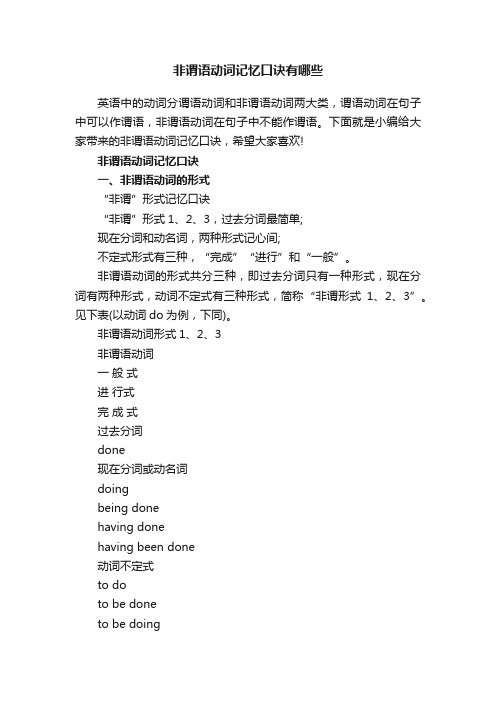
非谓语动词记忆口诀有哪些英语中的动词分谓语动词和非谓语动词两大类,谓语动词在句子中可以作谓语,非谓语动词在句子中不能作谓语。
下面就是小编给大家带来的非谓语动词记忆口诀,希望大家喜欢!非谓语动词记忆口诀一、非谓语动词的形式“非谓”形式记忆口诀“非谓”形式1、2、3,过去分词最简单;现在分词和动名词,两种形式记心间;不定式形式有三种,“完成”“进行”和“一般”。
非谓语动词的形式共分三种,即过去分词只有一种形式,现在分词有两种形式,动词不定式有三种形式,简称“非谓形式1、2、3”。
见下表(以动词do为例,下同)。
非谓语动词形式1、2、3非谓语动词一般式进行式完成式过去分词done现在分词或动名词doingbeing donehaving donehaving been done动词不定式to doto be doneto be doingto have doneto have been done从上表格中可以看出过去分词最简单,只有一种形式,即一般式done,现在分词分一般和完成两种形式,动词不定式有一般式、进行式和完成式三种形式。
熟记这些形式,是学好和用好非谓语动词的必要前提,必须在“熟”字上下功夫。
当我们在学习和使用非谓语动词时,大脑中首先浮现出“非谓语动词形式1、2、3”这幅图表,答题就有了较好的基础。
二、非谓语动词的功能非谓语动词总共有10种形式,每种形式用法均不同,不仅如此,有些非谓语动词的不同形式在句子中还可以充当同一功能(比如过去分词、现在分词和不定式均可在句中做定语),但存在区别。
以下表格(图2)仅介绍非谓语动词10种形式的主要功能及特点,详细用法可参看有关语法书籍。
非谓语动词各种形式功能表(图2)非谓语动词句中功能主要特点done定语、状语、表语、宾补被动,已经完成doing主语、定语、状语、表语、宾补主动,正在进行being done主语、定语、状语、宾补被动,正在进行having done状语、宾语、不能作定语主动,已经完成having been done状语、宾语、不能作定语被动,已经完成to do主语、宾语、表语、宾补、状语主动,将要发生to be done主语、宾语、表语、宾补、状语被动,将要发生to be doing宾语(常与动词搭配)主动,正在进行to have done宾语(常与动词搭配)主动,已经完成to have been done宾语(常与动词搭配)被动,已经完成说明:1.doing和to do 都可以作主语、宾语和表语,但to do 表示将要进行的“某一次”动作,doing则表示经常的动作(例1);它们都可以用作状语,但doing表示伴随或行为方式,而to do常表示目的(例2);2.doing/being done 和having done/having been done都可以在句中作状语,但dong/being done表示的动作常与谓语动词的动作同时或几乎同时发生,而having done/having been done表示的动作则发生在谓语动作之前(例3、例4);3.done,being done, to be done 这三个被动形式都可以在句子中作定语,但它们的时间概念有明显不同(例4-6);4.动词不定式的进行式和完成式常与一些动词搭配(例8、例9)。
(完整word版)非谓语动词的做题步骤

非谓语动词的做题步骤:1. 判定是谓语还是非谓语。
方法:找谓语动词。
如果句子已经有了谓语动词,要用的动词有下列情况:1)并列谓语(应有连词and,but,or等);2)并列句或从句谓语(应有从句、连词或分号“;”);3)非谓语动词(作主、宾、表、定、状、补等成分)。
2. 找非谓语动词的逻辑主语。
1)一般是句子的主语;2)定语的逻辑主语是所修饰词;3)宾语补足语的逻辑主语是宾语;4)独立主格结构的逻辑主语是分词前名词或代词。
3. 判断主被动关系。
方法:确定非谓语动词与其逻辑主语是主动还是被动关系。
4. 判断时间关系。
方法:分析句子,看非谓语动词动作发生在谓语动作之前、之后还是同时。
之前常用done; 之后常用to do; 同时常用doing。
注意:这些只用于一般情况,注意特殊情况,如:有些动词只接不定式作宾语,而有些动词只能接动词-ing形式作宾语。
再如:judging from等一类短语已是固定结构。
例如:1)The storm left, _____ a lot of damage to this area.A. causedB. have causedC. to causeD. having caused分析:(1)判断是谓语还是非谓语:句中left是谓语,cause要用非谓语形式,排除B项;(2)找逻辑主语:cause是“The storm left”的结果状语,逻辑主语是句子主语the storm;(3)判断主被动:cause a lot of damage是由the storm发出的,所以是主动,排除A(caused 作非谓语时是过去分词,表被动);(4)判断先后关系:cause damage与谓语动词left前已经发生,要用表示动作已经发生的having done。
答案:D。
2)______many times, he still couldn’t understand it .A. Having been toldB. Being toldC. He had been toldD. Though he was told分析:(1)判断是谓语还是非谓语:句中couldn’t understand是谓语,没有并列句连词and、but、so等,排除C;选项D是让步状语从句,但是many times经常用完成时表示强调,排除D。
初中英语:非谓语动词学习口诀包含动名词、动词的不定时顺口溜
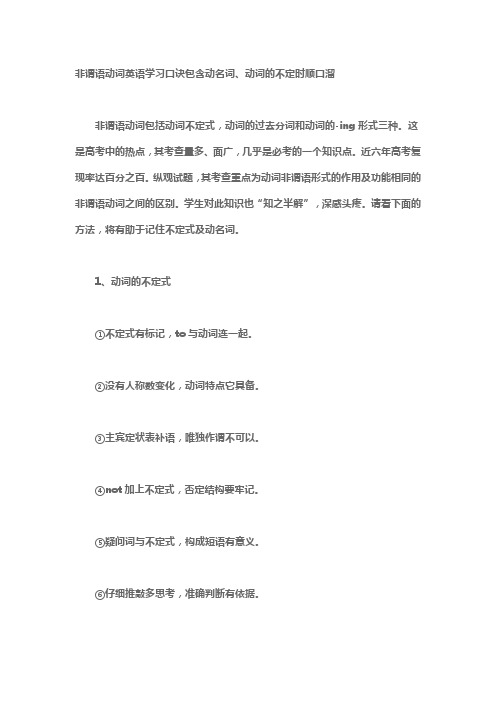
非谓语动词英语学习口诀包含动名词、动词的不定时顺口溜非谓语动词包括动词不定式,动词的过去分词和动词的-ing形式三种。
这是高考中的热点,其考查量多、面广,几乎是必考的一个知识点。
近六年高考复现率达百分之百。
纵观试题,其考查重点为动词非谓语形式的作用及功能相同的非谓语动词之间的区别。
学生对此知识也“知之半解”,深感头疼。
请看下面的方法,将有助于记住不定式及动名词。
1、动词的不定式①不定式有标记,to与动词连一起。
②没有人称数变化,动词特点它具备。
③主宾定状表补语,唯独作谓不可以。
④not加上不定式,否定结构要牢记。
⑤疑问词与不定式,构成短语有意义。
⑥仔细推敲多思考,准确判断有依据。
解析:①“to+动词原形”是它的基本构成形式,即不定式的标记。
②它没有人称和数的变化,不管主语是任何人称,单数还是复数,动词不定式都没有变化。
但它仍保留动词的特点,可以有自己的宾语或状语。
③它具有名词、形容词和副词三大特点,所以,它在句中可以作主语、宾语、定语、表语、状语和宾补。
④“not+动词不定式”是它的否定形式,不要受其他否定式的影响,要记住规律。
⑤疑问代词what,who,whom,which和疑问副词where,when,why,how加上不定式在句中可以做主语,宾语、表语、状语。
⑥通过以上分析,只要仔细研究,把不定式的功能用法搞清楚,在应用时就能作出准确的判断。
2、动名词:哪些动词后面只能接动名词,下面的顺口溜有助于记忆。
喜欢、考虑不可免(enjoy,consider,escape,avoid)停止,放弃太冒险(stop,give up,risk)反对想象莫推延(mine,imagine,delay,put off)要求完成是期望(require,finish,look forward to.)建议继续勤*练(suggest,go on,practise)不禁原谅要坚持(can’t help,excuse,insist on)继续注意使成功(keep on,mind,succeed in)。
非谓语动词解题三部曲
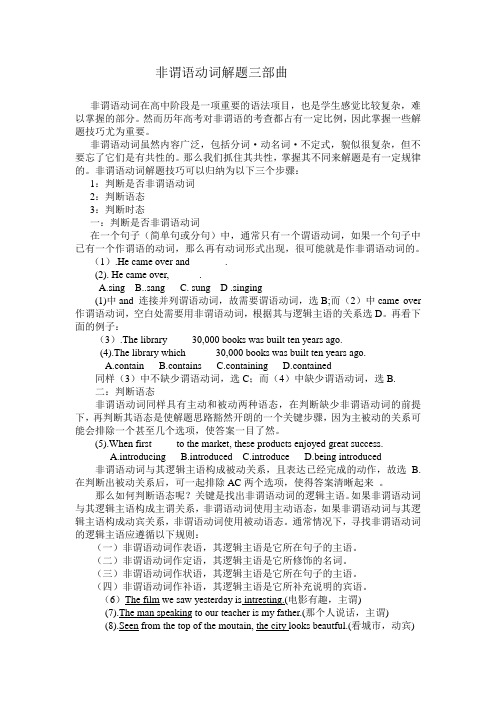
非谓语动词解题三部曲非谓语动词在高中阶段是一项重要的语法项目,也是学生感觉比较复杂,难以掌握的部分。
然而历年高考对非谓语的考查都占有一定比例,因此掌握一些解题技巧尤为重要。
非谓语动词虽然内容广泛,包括分词·动名词·不定式,貌似很复杂,但不要忘了它们是有共性的。
那么我们抓住其共性,掌握其不同来解题是有一定规律的。
非谓语动词解题技巧可以归纳为以下三个步骤:1:判断是否非谓语动词2:判断语态3:判断时态一:判断是否非谓语动词在一个句子(简单句或分句)中,通常只有一个谓语动词,如果一个句子中已有一个作谓语的动词,那么再有动词形式出现,很可能就是作非谓语动词的。
(1).He came over and ______ .(2). He came over, _____ .A.singB..sangC. sung D .singing(1)中and 连接并列谓语动词,故需要谓语动词,选B;而(2)中came over 作谓语动词,空白处需要用非谓语动词,根据其与逻辑主语的关系选D。
再看下面的例子:(3).The library_____30,000 books was built ten years ago.(4).The library which______30,000 books was built ten years ago.A.containB.containsC.containingD.contained同样(3)中不缺少谓语动词,选C;而(4)中缺少谓语动词,选B.二:判断语态非谓语动词同样具有主动和被动两种语态,在判断缺少非谓语动词的前提下,再判断其语态是使解题思路豁然开朗的一个关键步骤,因为主被动的关系可能会排除一个甚至几个选项,使答案一目了然。
(5).When first_____to the market, these products enjoyed great success.A.introducingB.introducedC.introduceD.being introduced非谓语动词与其逻辑主语构成被动关系,且表达已经完成的动作,故选 B.在判断出被动关系后,可一起排除AC两个选项,使得答案清晰起来。
非谓语动词三步法

非谓语动词遇到有关非谓语动词的单选题,可以根据句中的搭配结构、非谓语的主被动形式和非谓语的“时态”三个角度,从语言的结构到语义由简单到复杂依次排选。
第一步:根据非谓语形式在句中可作的成分来分析空白处可填入的非谓语形式,看能否在不定式、分词和动名词几个形式之间先排除一个或几个。
2).现在分词完成式不作定语。
1.非谓语形式作主语或宾语时,除“the 分词”外一般只能用不定式或动名词。
其中不定式作介词的宾语时要使用“特殊疑问词 不定式”结构。
例如:1).It’s very kind of you to help us.2).Fighting broke out between the South and the North.3).The driver failed to see other cars at the moment .4).Please show us how to do that.2.作状语时,不定式表示目的以及so/as to do和(only)to do中的结果状语,其它状语都用分词来表示。
例如:1).To sleep late the next morning,he turned off the alarm clock.(“非谓语 主句”模式中,非谓语在句首而且由逗号与主句隔开,此句中的不定式只作目的状语;此时的分词表示时间、原因或条件状语,有时分词前可加when,while,if,before, after,as和though等连词,如:①Given more attention,the trees could have grown better. ②When asked,never be silent.)2).He came here only to say good-bye to us.(不定式在句中作目的状语时它前面不能用逗号)3).He spoke a lot at the conference,only to show his ignorance on the topic.(不定式在主句之后,又有逗号与主句隔开时常用(only)to do形式表示出乎主语意料的结果)第二步:在第一步的基础上从非谓语的主被动形式这个角度进行筛选。
英语语法口诀非谓语动词
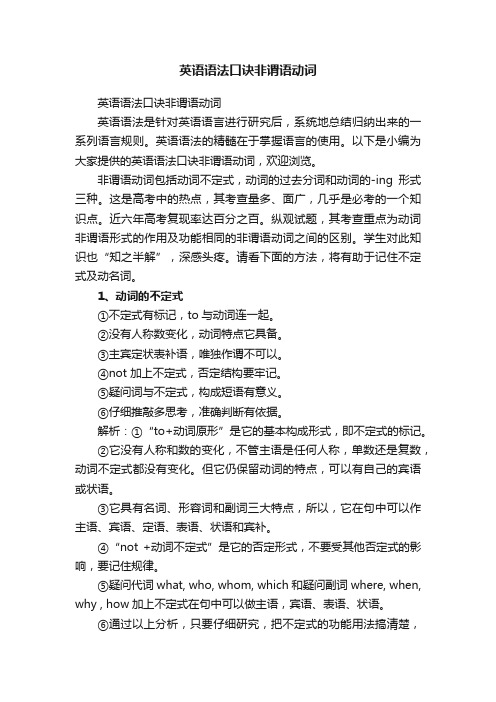
英语语法口诀非谓语动词英语语法口诀非谓语动词英语语法是针对英语语言进行研究后,系统地总结归纳出来的一系列语言规则。
英语语法的精髓在于掌握语言的使用。
以下是小编为大家提供的英语语法口诀非谓语动词,欢迎浏览。
非谓语动词包括动词不定式,动词的过去分词和动词的-ing形式三种。
这是高考中的热点,其考查量多、面广,几乎是必考的一个知识点。
近六年高考复现率达百分之百。
纵观试题,其考查重点为动词非谓语形式的作用及功能相同的非谓语动词之间的区别。
学生对此知识也“知之半解”,深感头疼。
请看下面的方法,将有助于记住不定式及动名词。
1、动词的不定式①不定式有标记,to与动词连一起。
②没有人称数变化,动词特点它具备。
③主宾定状表补语,唯独作谓不可以。
④not 加上不定式,否定结构要牢记。
⑤疑问词与不定式,构成短语有意义。
⑥仔细推敲多思考,准确判断有依据。
解析:①“to+动词原形”是它的基本构成形式,即不定式的标记。
②它没有人称和数的变化,不管主语是任何人称,单数还是复数,动词不定式都没有变化。
但它仍保留动词的特点,可以有自己的宾语或状语。
③它具有名词、形容词和副词三大特点,所以,它在句中可以作主语、宾语、定语、表语、状语和宾补。
④“not +动词不定式”是它的否定形式,不要受其他否定式的影响,要记住规律。
⑤疑问代词what, who, whom, which和疑问副词where, when, why , how加上不定式在句中可以做主语,宾语、表语、状语。
⑥通过以上分析,只要仔细研究,把不定式的功能用法搞清楚,在应用时就能作出准确的判断。
2、动名词:哪些动词后面只能接动名词,下面的顺口溜有助于记忆。
喜欢、考虑不可免(enjoy, consider, escape, avoid)停止,放弃太冒险(stop, give up , risk)反对想象莫推延(mine, imagine, delay, put off)要求完成是期望(require, finish, look forward to.)建议继续勤练(suggest, go on, practise)不禁原谅要坚持(can’t help, excuse , insist on)继续注意使成功(keep on, mind, succeed in)英语语法代词的分类1. 人称代词主格(在句中作主语)有: I , you, he, she, it, we, you, they宾格(在句中作宾语)有:me, you, him, her, it, us, you , them2. 物主代词形容词性的物主代词(作定语)有:my, your, his , her, its,our, your ,their名词性的物主代词(作主语、表语,宾语)有:mine, yours, his, hers, its,ours, yours, theirs3. 反身代词(自身代词)有 myself, herself, themselves等。
- 1、下载文档前请自行甄别文档内容的完整性,平台不提供额外的编辑、内容补充、找答案等附加服务。
- 2、"仅部分预览"的文档,不可在线预览部分如存在完整性等问题,可反馈申请退款(可完整预览的文档不适用该条件!)。
- 3、如文档侵犯您的权益,请联系客服反馈,我们会尽快为您处理(人工客服工作时间:9:00-18:30)。
非谓语动词遇到有关非谓语动词的单选题,可以根据句中的搭配结构、非谓语的主被动形式和非谓语的“时态”三个角度,从语言的结构到语义由简单到复杂依次排选。
第一步:根据非谓语形式在句中可作的成分来分析空白处可填入的非谓语形式,看能否在不定式、分词和动名词几个形式之间先排除一个或几个。
2).现在分词完成式不作定语。
1.非谓语形式作主语或宾语时,除“the 分词”外一般只能用不定式或动名词。
其中不定式作介词的宾语时要使用“特殊疑问词 不定式”结构。
例如:1).It’s very kind of you to help us.2).Fighting broke out between the South and the North.3).The driver failed to see other cars at the moment .4).Please show us how to do that.2.作状语时,不定式表示目的以及so/as to do和(only)to do中的结果状语,其它状语都用分词来表示。
例如:1).To sleep late the next morning,he turned off the alarm clock.(“非谓语 主句”模式中,非谓语在句首而且由逗号与主句隔开,此句中的不定式只作目的状语;此时的分词表示时间、原因或条件状语,有时分词前可加when,while,if,before, after,as和though等连词,如:①Given more attention,the trees could have grown better. ②When asked,never be silent.)2).He came here only to say good-bye to us.(不定式在句中作目的状语时它前面不能用逗号)3).He spoke a lot at the conference,only to show his ignorance on the topic.(不定式在主句之后,又有逗号与主句隔开时常用(only)to do形式表示出乎主语意料的结果)第二步:在第一步的基础上从非谓语的主被动形式这个角度进行筛选。
1.非谓语用作主语或状语时,一般根据它们的逻辑主语来判断主被动形式的选用;若无逻辑主语,则以主句主语为判断对象。
例如:1).Using the dictionary,I found it of great use.(作状语的分词逻辑主语和主句主语相同时,逻辑主语常省去)2).It’s so nice to hear your voice.3).Seeing is believing.(不带逻辑主语的不定式或动名词作主语时,通常看作第一人称的逻辑主语省略)注意以下特殊情况中非谓语一律用主动式:①主语 系动词 形容词 不定式②need/want/require(需要) doing③be worth doing2.作宾语或表语时,要根据主句主语来分析主被动形式。
例如:1).The little girl would like to be brought to the State with her brother.2).His story in the jungle is very exciting.3.作定语时,应根据被修饰词来选用主被动形式。
例如:1).I have a room to paint,so I can’t go out for a picnic with them.2).We have a room to be painted.Where can we find a worker?(当句中出现了作定语的不定式动词的执行者时用主动式,否则用被动式)4.作宾补的非谓语主被动形式要根据非谓语动词与宾语的关系来确定。
例如:1).Don’t have the water running like that.2).She sat alone in the room,with her eyes fixed on the ceiling.第三步:经过第一、二两步分析仍未能作出最后选择时,可能会剩下不定式和分词内部不同的式之间的选择,即非谓语的“时态”,这时可通过比较非谓语动词和谓语动词所发生的先后来判别。
1.不定式的一般式to do/to be done常用在①表示非谓语动词发生在谓语之后;例如:1).I hope to see you again soon.2).Who do you think our teacher will have work on the wall-newspaper?②表示与谓语动词同时发生的一个全过程动作或谓语当时所处的状态。
例如:4).Have you seen a little boy go into the house?5).He seems to know that.2.不定式的进行式to be doing 和现在分词的一般式doing/being done只用来表示非谓语动词和谓语动词同时发生。
例如:1).The secretary worked late into the night, preparaing the long speech for the president.2).They pretended to be sleeping when Mother came in.3.不定式完成式to have done/to have been done和现在分词完成式having done/having been done 均表示动作发生在谓语之前。
例如:1).He is said to have left.2).Not having heard from him,I wrote to him again.4.词常表示发生在谓语之前而及物动词的过去分词则可以指发生在谓语之前或与谓语同时的状态。
例如:1).fallen leaves/a burnt-out match2).The thief was brought in,with his hands tied behind.若非谓语形式正确而词义仍不同者则需从句义来考虑。
非谓语动词的一般式表示的动作与谓语动词表示的动作同时发生或在其后发生,非谓语动词的完成式表示的动作发生在谓语动词表示的动作之前。
1.动词不定式例1:A lot of young people are learning to drive cars. (同时发生)例2:All of us expected to discover a new oil field. (非谓语动词动作发生在后)例3:He is said to have studied English for three years. (非谓语动词动作发生在前)注:动词不定式的完成式有时用在intended, expected, meant, were to, was to等过去式的动词后面,表示未实现的行为。
例如:1)I meant to have sent the book to you by mail. (我本想把这本书邮寄给你的。
)2)He was to have been the new ambassador, but he fell ill. (他原是要任新大使的,但是他病了。
)2.动名词例1:I am thinking of getting a new dictionary. (非谓语动词动作发生在后)例2:We enjoy watching colour TV. (与谓语动词动作同时)例3:He forgot having promised to write things for us. (非谓语动词动作发生在前。
)3.分词例1:Singing a song, he came into the room. (非谓语动词动作与谓语动词动作同时发生)例2:Having written his composition, he went to have a heart to heart talk with Wang. (非谓语动词动作发生在前)非谓语动词的比较1.动名词和动词不定式在用法上的比较(1)一般说来动名词所表示的动作在意义上是比较抽象的、一般的,时间概念不强,不是指某一次的动作;而动词不定式所表示的动作则往往是具体的一次行为。
例如:1)I like swimming, but I don’t like to swim today.2) They prefer staying indoors when the weather is cold.3) Would you prefer to stay at home this evening?(2)动词不定式的逻辑主语,常常是句子的主语或句中的某个词;而动名词的逻辑主语可能是句子主语或句中某个词,也可能是泛指一般人物,在句子里是找不着的。
例如:1)I hate to be sitting idle. (我不想闲坐着。
)(指自己)2)I hate saying nothing at a meeting but gossiping afterwards. (我不喜欢开会不说会后乱说。
)(可能指自己,也可能泛指一般人)(3)有些词后既可接动名词亦...1不定式作宾语1) 动词+ 不定式afford aim appear agree arrange ask be decide bother care choose come dare demand desire determine expect elect endeavor hope fail happen help hesitate learn long mean manage offer ought plan prepare pretend promise refuse seem tend wait wish undertakeThe driver failed to see the other car in time. 司机没能及时看见另一辆车。
I happen to know the answer to your question. 我碰巧知道你那道问题的答案。
2)动词+不定式;动词+宾语+不定式ask, beg, choose, expect , hate, help intend like, love, need prefer, prepare, promise, want, wish…I like to keep everything tidy.我喜欢每件东西都保持整洁。
